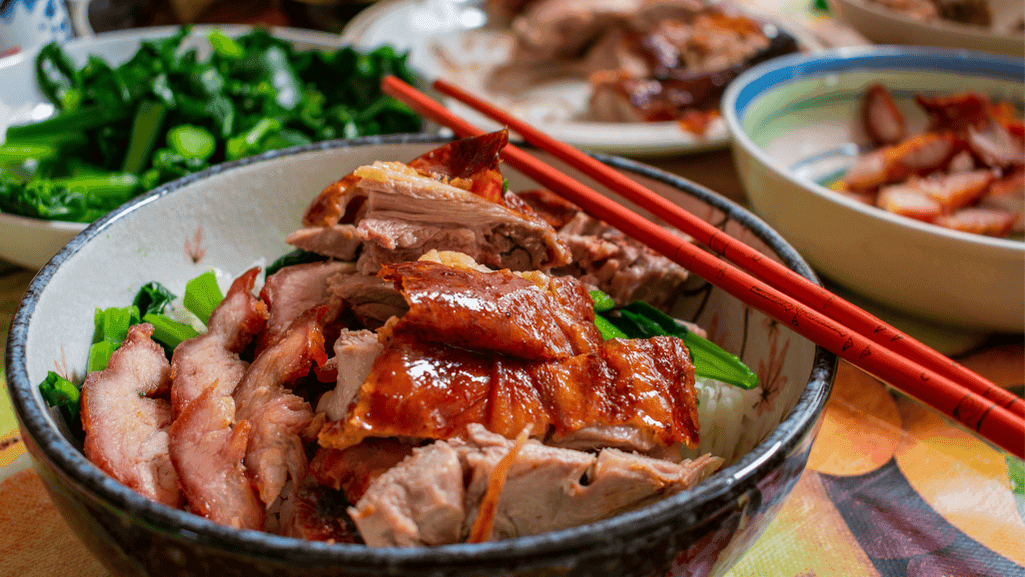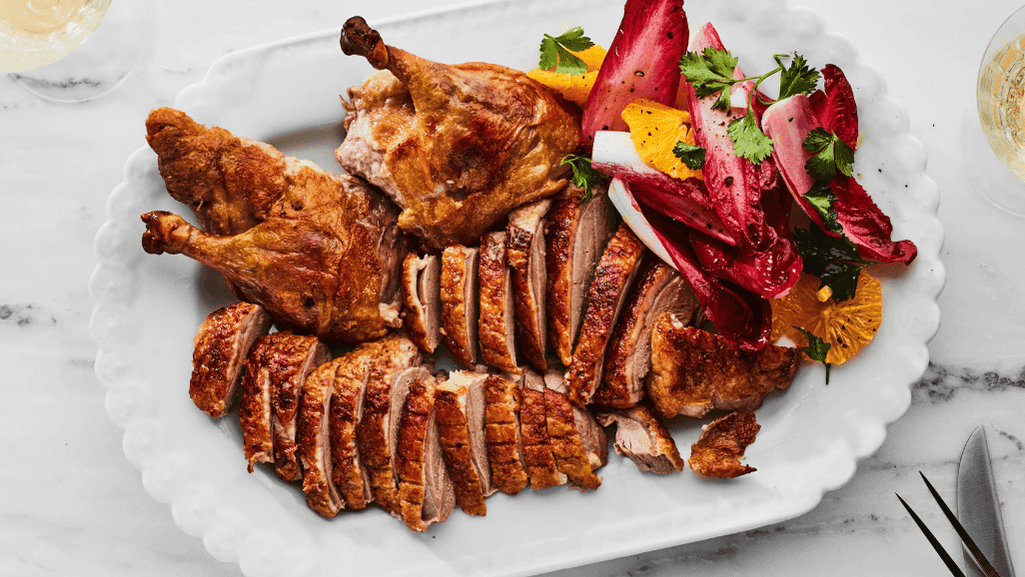There are many duck breeds to choose from for a tasty meal. Each has its own flavor and cooking style. Knowing the differences helps pick the right duck for your dish.
The White Pekin duck is the top choice in the U.S., making up 95% of duck meat. They are loved for their mild taste, less fat, and more protein. Every year, about 39 million Pekin ducks are raised for their meat.
Muscovy ducks are great for those who want a bolder taste, thanks to their liver. They have more fat than Pekin ducks and taste stronger. Mulard ducks, a mix of Muscovy and Pekin, also offer a rich flavor. Raised longer, they have more fat, a firmer texture, and a gamier taste than Pekin ducks.
Mallard ducks are less common but sometimes hunted or raised on farms. They are smaller and leaner than Pekin ducks but have little fat. Wild ducks can have pollutants like PCBs, which are harmful to health, so eating them often is risky.
Key Takeaways
- White Pekin ducks are the most popular choice for eating, known for their mild flavor and low fat content.
- Muscovy ducks offer a stronger flavor profile and are often chosen for their liver.
- Mulard ducks, a Muscovy and Pekin crossbreed, have a gamier taste and tougher texture due to being raised to an older age.
- Mallard ducks are less common but are sometimes hunted as game or farm-raised.
- Wild ducks may be contaminated with pollutants, so caution should be exercised when consuming them frequently.
Overview of Duck as a Culinary Choice
Duck is a versatile and flavorful meat that’s becoming more popular. It offers a unique taste and nutritional benefits. It’s a great choice for those wanting to try something new in the kitchen.
Nutritional Benefits of Duck
Duck meat is packed with nutrients like iron, niacin, vitamin E, and selenium. These help protect cells. A 4-ounce serving of All Natural Boneless Duck Breast has 180 calories and 16 grams of protein.
Interestingly, skinless duck breast has fewer calories than skinless chicken breast. This makes it a nutritious and satisfying option.
Duck is considered a red meat because of its color and taste. It has monounsaturated fats, similar to olive oil, which can lower LDL cholesterol. When cooked right, up to 70% of the fat can be removed.
Common Preparations and Cooking Methods
Duck is very versatile in the kitchen. It can be roasted, grilled, smoked, or braised. This allows for many delicious dishes.
Marinades can make duck meat even more flavorful and tender. This makes it a favorite among food lovers.
When cooking duck, it’s important to know about its nutritional needs. Different stages of a duck’s life require different diets. For example, starter ducks need 20-22% protein, while grower and breeder ducks need 17-19% and 16% protein, respectively.
By understanding duck’s nutritional value and trying different cooking methods, you can make amazing dishes. These dishes will highlight duck’s unique flavors and textures.
Popular Duck Breeds for Consumption
There are many duck breeds loved for their taste around the world. Each has its own flavor and cooking style, making them great for different dishes.
Pekin Duck
The Pekin duck is a favorite in the U.S., making up 95% of duck sales. It’s known for its mild taste and tender meat. Its crispy skin is a hit with duck lovers.
Muscovy Duck
Muscovy ducks have bigger breasts and less fat than Pekin ducks. They are sold by gender, with males being bigger. Their meat is rich and perfect for grilling or pan-searing.
Mulard Duck
The Mulard duck is a mix of a Muscovy male and a Pekin female. It’s big and known for its foie gras. Its meat is strong and flavorful, often described as robust and flavorful.
Choosing a duck breed depends on your dish’s needs. Whether you like the mild taste of Pekin, the lean meat of Muscovy, or the rich taste of Mulard, there’s a breed for everyone.
Regional Dishes Featuring Duck
Duck is a versatile ingredient found in many cuisines worldwide. It leads to a variety of popular duck dishes. From French duck confit to Chinese Peking duck, each place has its own special way of cooking it.
French Duck Recipes
French cuisine is famous for its Moulard duck dishes. One classic is duck leg confit. It’s made by curing duck legs with salt and herbs for 12 to 24 hours. Then, they’re slowly cooked in their own fat for 4 to 7 hours.
This makes the meat tender and flavorful. It’s great as a main dish or in salads and other recipes.
Another famous French dish is caneton à la presse. It involves partially roasting a duck. Then, pressing its carcass to get the juices for a rich sauce.
Chinese Duck Dishes
Chinese cuisine is home to the famous Peking duck. This dish has a whole duck that’s air-dried and glazed with sweet syrup. It’s roasted until the skin is crispy and the meat is tender.
The duck is served with thin pancakes, scallions, and hoisin sauce. This lets diners make their own tasty wraps.
Southern US Duck Cuisine
In the southern United States, duck is used in hearty dishes like gumbo. This stew includes various duck species, andouille sausage, vegetables, and dark roux. Making duck gumbo is a big task, often taking a full day.
“Duck is like the filet mignon of poultry – it’s rich, it’s decadent, and it’s perfect for any special occasion.”
Exploring popular duck dishes reveals a world of flavors and cooking techniques. It shows how versatile and beloved this bird is.
How to Select Quality Duck for Cooking
Choosing the right duck is key to making delicious dishes. Whether you like wild or domesticated ducks for food, knowing what to look for is important.
The White Pekin is the most common duck in the U.S. It’s known for its mild taste and soft texture. Maple Leaf Farms provides USDA Grade A duck, processed with natural ingredients. Duck is now found in many places, from casual restaurants to home kitchens.
What to Look for in Fresh Duck
Look for a plump, moist duck with no blemishes. Younger ducks have softer skin. Fresh duck is best for immediate cooking, while frozen is convenient for later.
Organic vs. Conventional Duck
Organic ducks are raised without harmful chemicals. Free-range ducks are leaner and taste better than those raised indoors.
“Wild ducks are generally less fatty than domestic ducks found in stores or butcher shops due to their active lifestyle, flying hundreds or thousands of miles twice a year.”
Understanding Duck Labels
Learn to read duck labels to make better choices. Look for “USDA Grade A” or “Minimally Processed.” Labels can tell you about the duck’s origin and how it was raised.
Knowing how to pick quality duck will help you make tasty dishes. Maple Leaf Farms’ Easy Guide is a great resource for improving your duck cooking.
Cooking Techniques for Duck
When preparing duck recipes, several techniques can make the flavor and texture better. Ducks like mallard and pintail have a rich taste from eating acorns and corn. Larger ducks are great for roasting whole, while smaller ones are better for individual dishes.
Let the duck sit at room temperature before cooking for even cooking. Scoring the skin makes it crispy. Marinating in herbs and spices makes the duck taste better and tenderer.
Roasting Duck
Roasting is a classic way to cook duck. Pekin ducks are good for roasting because of their mild flavor and fat. Roasting at 275 degrees Fahrenheit makes the duck tender and flavorful. Letting it rest for 6-8 minutes makes the meat juicy.
Grilling and Smoking Duck
Grilling and smoking duck give it a special flavor. For duck breasts, cook to 145-150 degrees Fahrenheit for medium rare. Grilling skin-on duck with a cold skillet makes the skin crispy. Smoking with wood chips adds a smoky taste.
Braising Duck
Braising makes duck thighs, wings, and drums tender and flavorful. Slow cooking in a flavorful liquid like stock or wine makes the meat tender. A pan sauce with bourbon, stock, and orange juice can add more flavor.
Trying different cooking methods and ingredients can lead to many tasty duck dishes. This shows how versatile and rich duck can be.
Pairing Duck with Sides and Sauces
Creating a memorable duck dish starts with the right sides and sauces. Whether you’re using farm-raised duck or duck from hunting, the right pairings are key. They make your meal satisfying and enjoyable.
Best Vegetable Pairings
Vegetables are great with duck, adding flavors and textures. Roasted veggies with herbs like rosemary or thyme add color and heartiness. Green beans, asparagus, and Brussels sprouts are also good choices, balancing the duck’s flavor.
For a lighter side, try a spinach salad with pomegranate seeds or an arugula salad with balsamic vinaigrette. These salads are bright and flavorful. They help balance the duck’s richness, making the meal complete.
Ideal Sauces for Duck Dishes
Sauces are essential for duck dishes, and there are many to try. Fruit-based sauces like cherry or orange are favorites. A honey-citrus glaze, made with honey, orange juice, sugar, and cornstarch, is sweet and tangy. It’s perfect for duck.
For a savory option, try a pomegranate sauce with pomegranate juice, star anise, and chicken stock. It adds depth and lets the duck stand out. Other great sauces include hoisin and pepper jelly, each bringing unique flavors.
When choosing sides and sauces, think about flavor and texture balance. The right pairings will make your duck dish memorable. They highlight the versatility and richness of duck.
Tips for Storing and Preparing Duck
Storing and preparing duck right is key for the best taste and quality. Whether you buy it from a local farm or a specialty store, following the right steps is important. This ensures your dish turns out delicious.
Fresh duck should stay in the fridge for no more than two days. Frozen duck can last longer. When thawing frozen duck, do it safely in the fridge overnight. This prevents harmful bacteria from growing.
Duck has more fat than chicken, so it spoils faster if not stored right.
Proper Storage Practices
Most supermarkets don’t sell whole ducks. Boneless duck breasts are usually vacuum-sealed. Buying from places like D’Artagnan or LaBelle Farms is better. They offer air-chilled ducks, which are perfect for dry-aging.
Thawing Frozen Duck Safely
Always thaw frozen duck in the fridge overnight. This slow thawing is safe and prevents bacteria growth. Never thaw it at room temperature, as it can be unsafe.
Marinating Duck for Enhanced Flavor
Marinating duck adds rich flavors to your dish. Use citrus fruits, fresh herbs, or Asian marinades. Remove excess skin and fat from the duck legs and cavity for easier marinating. Salting the duck before cooking also makes it juicier and tastier.
By following these tips, you’ll make delicious dishes with duck. It’s great for any occasion, whether you’re a pro chef or a home cook. Duck is a versatile protein that’s sure to impress.
Conclusion: Embracing Duck in Your Culinary Repertoire
Duck is a versatile bird with many culinary uses. From Pekin to Muscovy and Mulard, each breed has its own taste. By trying different cooking techniques and flavors, you can make unforgettable meals.
When picking duck, choose quality and fresh meat. Look for organic or conventional duck from trusted sources. Keep the meat fresh by storing it properly. Frozen duck stays good for up to six months, perfect for cooking at home.
Encouraging Experimentation with Duck Recipes
Be bold and try new duck recipes. Enjoy classics like Duck à l’Orange or Chinese Peking Duck. Try roasting, grilling, smoking, or braising to find your favorite way to cook. Pair your duck with sides and sauces to make your meal even better.
Final Thoughts on Duck as Food
Exploring duck in your cooking is a fun adventure. Learn about different breeds, cooking methods, and flavors. Duck is a great way to get creative in the kitchen. So, when you wonder “what kind of duck to use,” remember the endless possibilities in duck cuisine.












